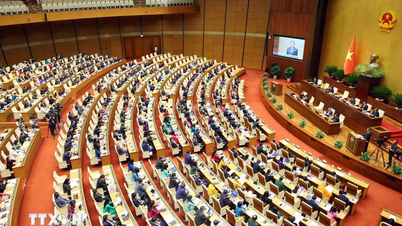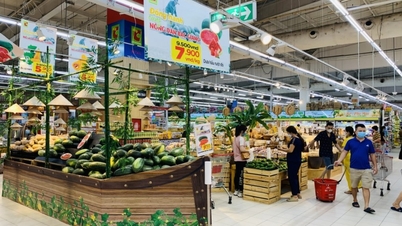When social networks dominate the media
After decades of shrinking revenue, the global media industry has reached a crisis point, declining more and more, even forcing many media organizations in the world and in Vietnam to accept their fate of living off others, becoming unpaid workers for social networks such as Facebook, TikTok, Twitter... or search platforms of Google and Microsoft.

Social networks, thanks to their use of technology and algorithms, are completely overwhelming the traditional press industry. Illustration: GI
The latest collapse of Buzzfeed News, which was seen as a model of success in the digital media era, after hundreds of thousands of other online and traditional print newspapers around the world have also had to close, must have sounded a final warning bell for the world of journalism.
There is no debate at this point that social media platforms and technology are the main agents, whether directly or indirectly, that are stifling journalism, not just in one country or one region but on a global scale.
BuzzFeed News co-founder and CEO Jonah Peretti himself had to bitterly admit that his recently shuttered news site was a victim of the technology and social media world, even in the way that a boss was one day kicked out of his own house by his employees.
BuzzFeed News, a pioneer in digital news, pushed the early growth of platforms like Facebook and Twitter to new heights. While competitors were wary, BuzzFeed believed in these platforms, exploiting them to capture the attention of readers and reaping incredible success.
But then, like an oil field drying up, publishers could no longer rely on Facebook as a source of traffic and revenue. Peretti admits that he was slow to realize that “social media platforms will not help support journalism’s circulation or finances, even if that journalism model is purpose-built for social media.”
Like Peretti, other news sites and press organizations had to close down when they realized the harsh truth, it was too late!
The Dark Side of Social Media Dependence
While there is no single cause for the decline of traditional media industries, much of the blame falls on online social platforms, whose profits have largely increased even as journalism funding has withered.
According to international media experts, there is a connection between these two opposing trends. It is because of the control that social platforms have over how we access information. That means news media organizations are too dependent on social media and technology platforms to distribute their products.
As a result, Facebook, Google, and TikTok have almost gained the “power of life and death” over the online distribution of news products (through algorithms). From there, they have used this advantage to dominate the online advertising market, keeping the largest portion of profits for themselves!
The invasion of social media and technology platforms has not only cut off most of the revenue streams of newspapers, both online and print, but also taken away a lot of their brainpower. When social media and sharing platforms become fertile ground, where millions of readers are constantly present, journalists are forced to "flock" there, especially in the context of many news organizations being forced to cut jobs, royalties and, as mentioned, even having to close down.

There is no denying that many news organizations around the world are still overly dependent on social media platforms and technology to distribute news. Illustration photo: GI
In a recent Pew Research Center survey, 94% of U.S. journalists said they use social media professionally. At the same time, two-thirds of them said social media has a “somewhat” to “very negative” impact on their work.
Despite warnings, news organizations around the world failed to anticipate the extent of social media’s influence. Starting out as intermediaries between news outlets and users, social media platforms quickly expanded their role to create engagement with readers. Today, TikTok, Facebook, Twitter, and Instagram are even competing with news outlets to become the main access point for information.
Need cooperation and solidarity
One of the many examples of news organizations that relied on social media and were painfully “ousted” is the Hungarian news agency Atlatszo. Initially, they were very excited and optimistic about their growth, with hundreds of thousands of users following them on Facebook.
But then, surprisingly, the actual audience engagement and reach of their posts has been declining over time. This is largely due to a policy change in 2018, when Facebook announced that its algorithm would prioritize “posts that spark meaningful conversations and interactions” among friends and family. Other platforms have since followed suit.
Atlasszo and many other news organizations must have felt “betrayed” at the time, but could only stand by and watch helplessly. According to the latest statistics, news accounts for only 3% of content on Facebook news feeds. The ratio on other social networks is not much better.
Leticia Duarte, a Brazilian journalist and program manager at Report for the World, explains that after gaining readership from newspapers, social media algorithms have been redesigned to disseminate “emotional” content over “nonsense,” “sensational” stories to attract engagement and create virality.
It is easy to see that such content is more attractive to users than news articles, but it also creates waves of misinformation, fake news and toxic news that spread quickly throughout society.
Thus, it can be said that it is time for the press and media industry to review its relationship with technology platforms and social networks, especially in the digital space. And according to experts and policy trends in some countries, one of the solutions is to force these platforms to share profits when using press information; at the same time, governments must introduce strict rules that force technology platforms to censor content well, preventing false and harmful information.
This is an ideal but long-term scenario that requires a coordinated effort from governments, platforms, advertisers… and especially the solidarity of traditional news organizations.
Hai Anh
Read Part 2: How technology platforms stifle journalism around the world
Source






![[Photo] Vietnam and Sri Lanka sign cooperation agreements in many important fields](https://vphoto.vietnam.vn/thumb/1200x675/vietnam/resource/IMAGE/2025/5/5/9d5c9d2cb45e413c91a4b4067947b8c8)




























































































Comment (0)